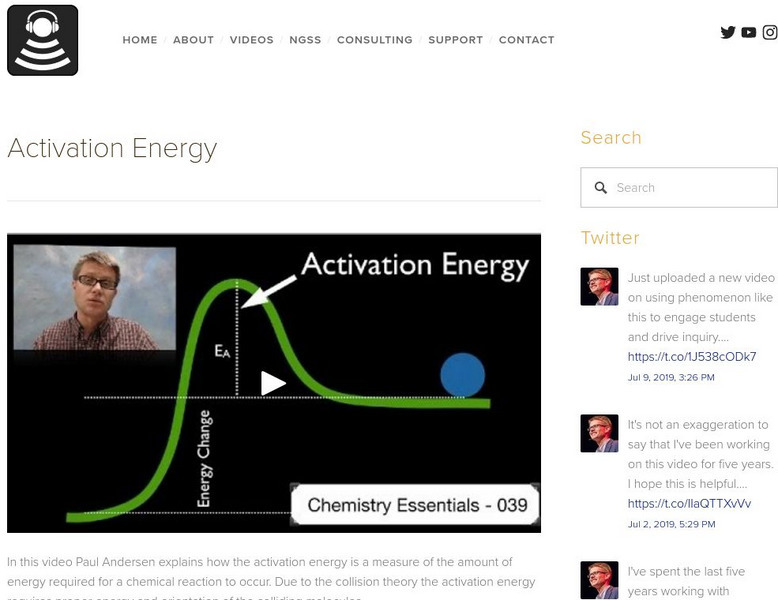SciShow
Where Did the Moon Come From?
SciShow Space takes you to the moon! Learn about the competing theories about how Earth's closest neighbor formed.
Bozeman Science
PS1B - Chemical Reactions
In this video Paul Andersen explains how chemical reactions progress as bonds are broken and reformed reformed. He explains the difference between changes in state and changes in molecules. He discussed collision theory and explains why...
Curated Video
Navigating Effective and Ineffective Collisions in Collision Theory
Collision Theory, Decomposition of Hydrogen Iodide, Activation Energy, Activated complex, Volleyball game analogy,Effective& ineffective collisions. Collision Theory & Arrhenius Factor part 1
Curated Video
GCSE Chemistry - Factors Affecting the Rate of Reaction #47
This video covers: - Collision theory, and how it relates to the rate of reaction - The effect of temperature - The effect of concentration and pressure - The effect of surface area - The effect of catalysts
Curated Video
Collision Theory on Bond Formation and Reaction Rates
Explains how particles collide for a reaction to occur and how this process affects the rate of a reaction.
Curated Video
Investigating the Effect of Surface Area on the Rate of Reaction
The video discusses the topic of investigating the effect of surface area on the rate of chemical reactions. The presenter explains the concept of collision theory and how chemical reactions occur when particles collide with each other....
Curated Video
Understanding Chemical Reactions: Collision Theory and Catalysts
This video discusses collision theory and how it applies to chemical reactions. The concept of activation energy and how it relates to the rate of a chemical reaction is explained. The video goes on to explore three ways that the rate of...
Curated Video
Understanding Collision Theory and Activation Energy for Chemical Reactions
The video explains collision theory and activation energy in chemistry. It demonstrates the concept of how reacting particles need to collide with sufficient energy to break reactant bonds and form new products. The video also explains...
Catalyst University
Kinetics: Lindemann Mechanism Derivation
Kinetics: Lindemann Mechanism Derivation
Weird History
The Kursk | What Happened to the Russian Sub That Exploded
When the Russian submarine Kursk sank in 2000, it was a conspiracy theorist's dream come true. Immediately, conflicting stories started pouring in from official sources, ranging from a US submarine ramming the Kursk to a potential...
FuseSchool
Collision Theory & Reactions Part 2
Learn about Collision Theory, what happens in a reaction and why some reactions are endothermic and some are exothermic.
FuseSchool
Collision Theory & Reactions Part 1
In this video learn about Collision Theory and find out what is necessary for reactions to take place.
Professor Dave Explains
Kinetics: Initial Rates and Integrated Rate Laws
Who likes math! Oh, you don't? Maybe skip this one. Unless you have to answer this stuff for class. Then yeah, watch this.
Professor Dave Explains
Energy Diagrams, Catalysts, and Reaction Mechanisms
It's time to learn a little more about a chemical reaction. How do molecules have to be arranged and how much energy do they have to collide with? What's a catalyst? Lots of great tidbits in this one.
Crash Course
Kinetics: Chemistry's Demolition Derby
Make kinetics interesting with a video that compares kinetics to a demolition derby. The presentation information about collisions, activation energy, writing rate laws, equilibrium expressions, reaction mechanisms, and...
Bozeman Science
PS1B—Chemical Reactions
Thinking back to the last time you taught a lesson on chemical changes ... was there no reaction? Check out an explosive video to put some spark back in your instruction! The narrator of the video guides you through the...
Teacher's Pet
Factors Affecting Reaction Rates
You can speed up or slow down a reaction when you know these factors. Learners explore the factors affecting reaction rates such as catalysts and inhibitors, temperature, surface area, and concentration. The video provides examples for...
Teacher's Pet
Collision Theory
Teach the three components of the collision theory through a video lesson. The narrator explains what it takes for a reaction to occur. A perfect combination of collisions, energy, and orientation and a reaction is underway.
Fuse School
Diffusion of Gases
Phew, what's that smell? And, how does something like a scent travel from its source to all corners of a room? Science sleuths learn how diffusion is responsible for spreading odors around in the sixth installment in a 14-part video...
Fuse School
Collision Theory and Reactions—Part 2
Get a positive reaction from your class as they explore the energy of reactions through a video analysis. The second lesson in a series of 35 explains energy absorption and release during chemical reactions. Graphs track the energy to...
Fuse School
Collision Theory and Reactions
The first lesson in a 35-part video series explains how orientation and energy determine a successful collision reaction. Scholars examine the requirements for a collision reaction to take place and come to understand that the...
Flipping Physics
AP Physics 1: Linear Momentum and Impulse Review
Help pupils review for the portion of the AP Physics exam that covers linear momentum and impulse review with a short video that covers an extensive amount of material.
DoodleScience
Collisions
What can you learn in two minutes? In this case, you can learn about collisions. Kinetic energy, momentum, elastic, and inelastic collisions are all included with definitions and a quick example of each.
Bozeman Science
Bozeman Science: Activation Energy
In this video Paul Andersen explains how the activation energy is a measure of the amount of energy required for a chemical reaction to occur. Due to the collision theory the activation energy requires proper energy and orientation of...










